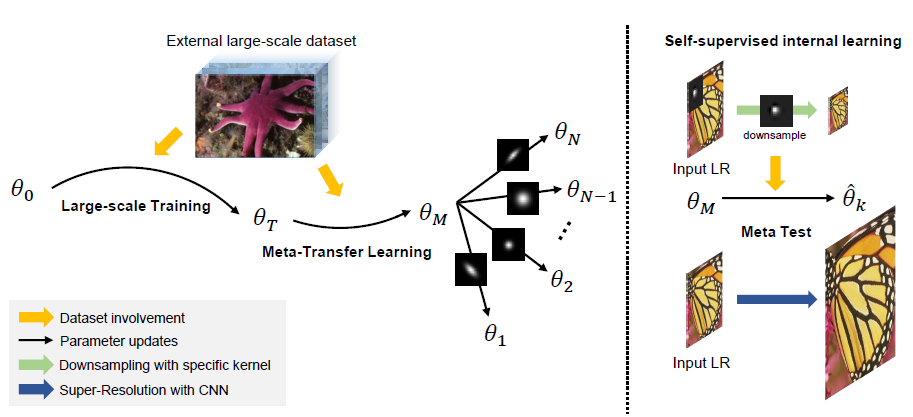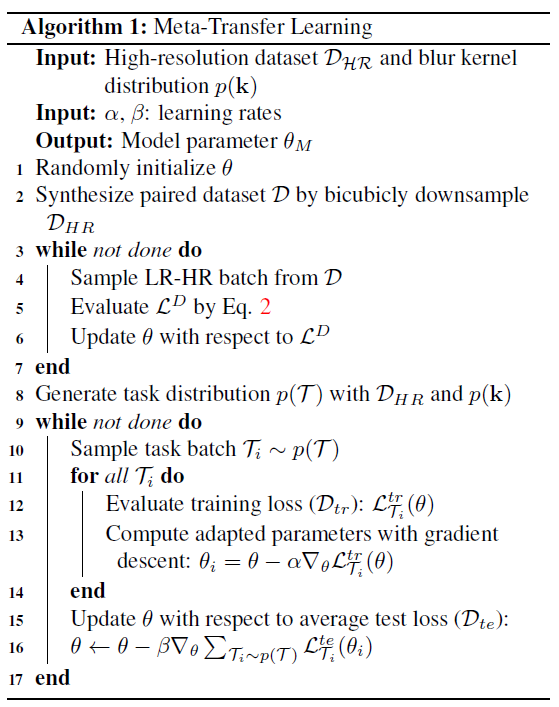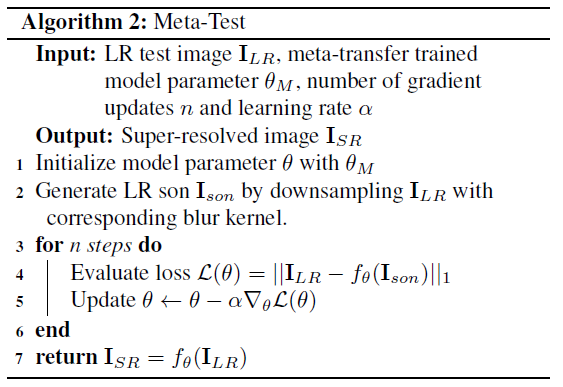JWSoh / Mzsr
Programming Languages
Projects that are alternatives of or similar to Mzsr
MZSR
Meta-Transfer Learning for Zero-Shot Super-Resolution CVPR 2020
Jae Woong Soh, Sunwoo Cho, and Nam Ik Cho
[Paper] [Supplementary] [Arxiv]
Environments
- Ubuntu 18.04
- Tensorflow 1.8
- CUDA 9.0 & cuDNN 7.1
- Python 3.6
Abstract
Convolutional neural networks (CNNs) have shown dramatic improvements in single image super-resolution (SISR) by using large-scale external samples. Despite their remarkable performance based on the external dataset, they cannot exploit internal information within a specific image. Another problem is that they are applicable only to the specific condition of data that they are supervised. For instance, the low-resolution (LR) image should be a "bicubic" downsampled noise-free image from a high-resolution (HR) one. To address both issues, zero-shot super-resolution (ZSSR) has been proposed for flexible internal learning. However, they require thousands of gradient updates, i.e., long inference time. In this paper, we present Meta-Transfer Learning for Zero-Shot Super-Resolution (MZSR), which leverages ZSSR. Precisely, it is based on finding a generic initial parameter that is suitable for internal learning. Thus, we can exploit both external and internal information, where one single gradient update can yield quite considerable results. (See Figure 1). With our method, the network can quickly adapt to a given image condition. In this respect, our method can be applied to a large spectrum of image conditions within a fast adaptation process.
Related Work
Super-Resolution for Various Kernels
[ZSSR (CVPR 2018)] "Zero-Shot" Super-Resolution Using Deep Internal Learning Link
[IKC (CVPR 2019)] Blind Super-Resolution With Iterative Kernel Correction Link
Optimization-based Meta-Learning
[MAML (ICML 2017)] Model-Agnostic Meta-Learning for Fast Adaptation of Deep Networks Link
[MAML++ (ICLR 2019)] How to train your MAML Link
Brief Description of Our Proposed Method
Illustration of the Overall Scheme
During meta-transfer learning, the external dataset is used, where internal learning is done during meta-test time. From random initial \theta_0, large-scale dataset DIV2K with “bicubic” degradation is exploited to obtain \theta_T. Then, meta-transfer learning learns a good representation \theta_M for super-resolution tasks with diverse blur kernel scenarios. In the meta-test phase, self-supervision within a test image is exploited to train the model with corresponding blur kernel.
Algorithms
Left: The algorithm of Meta-Transfer Learning & Right: The algorithm of Meta-Test.
Experimental Results
Results on various kernel environments (X2)
The results are evaluated with the average PSNR (dB) and SSIM on Y channel of YCbCr colorspace. Red color denotes the best results and blue denotes the second best. The number between parantheses of our methods (MZSR) denote the number of gradient updates.
Results on scaling factor (X4)
Test Input Data
Degraded Images of Set5, B100, Urban100 on various kernel environments.
Visualized Results
Brief explanation of contents
├── GT: Ground-truth images
├── Input: Input LR images
├── Model: Pre-trained models are included (Model Zoo)
├──> Directx2: Model for direct subsampling (x2)
├──> Multi-scale: Multi-scale model
├──> Bicubicx2: Model for bicubic subsampling (x2)
└──> Directx4: Model for direct subsampling (x4)
├── Pretrained: Pre-trained model (bicubic) for transfer learning.
└── results: Output results are going to be saved here.
Rest codes are for the training and test of MZSR.
Guidelines for Codes
Requisites should be installed beforehand.
Clone this repo.
git clone http://github.com/JWSoh/MZSR.git
cd MZSR/
Training
Download training dataset DIV2K.
Generate TFRecord dataset
- Refer to MainSR repo.
- Run generate_TFRecord_MZSR.py
Train MZSR
Make sure all configurations in config.py are set.
[Options]
python main.py --train --gpu [GPU_number] --trial [Trial of your training] --step [Global step]
--train: Flag in order to train.
--gpu: If you have more than one gpu in your computer, the number denotes the index. [Default 0]
--trial: Trial number. Any integer numbers can be used. [Default 0]
--step: Global step. When you resume the training, you need to specify the right global step. [Default 0]
Test
Ready for the input data (low-resolution) and corresponding kernel (kernel.mat file.)
[Options]
python main.py --gpu [GPU_number] --inputpath [LR path] --gtpath [HR path] --savepath [SR path] --kernelpath [kernel.mat path] --model [0/1/2/3] --num [1/10]
--gpu: If you have more than one gpu in your computer, the number designates the index of GPU which is going to be used. [Default 0]
--inputpath: Path of input images [Default: Input/g20/Set5/]
--gtpath: Path of reference images. [Default: GT/Set5/]
--savepath: Path for the output images. [Default: results/Set5]
--kernelpath: Path of the kernel.mat file. [Default: Input/g20/kernel.mat]
--model: [0/1/2/3]
-> 0: Direct x2
-> 1: Multi-scale
-> 2: Bicubic x2
-> 3: Direct x4
--num: [1/10] The number of adaptation (gradient updates). [Default 1]
You may change other minor options in "test.py." Line 9 to line 17.
The minor options are shown below.
self.save_results=True -> Whether to save results or not.
self.display_iter = 1 -> The interval of information display.
self.noise_level = 0.0 -> You may sometimes add small noise for real-world images.
self.back_projection=False -> You may also apply back projection algorithm for better results.
self.back_projection_iters=4 -> The number of iteration of back projection.
An example of test codes
python main.py --gpu 0 --inputpath Input/g20/Set5/ --gtpath GT/Set5/ --savepath results/Set5 --kernelpath Input/g20/kernel.mat --model 0 --num 1
Extra: Codes for Large-Scale Pretraining
Please refer to the folder Large-Scale_Training.
Citation
@article{soh2020meta,
title={Meta-Transfer Learning for Zero-Shot Super-Resolution},
author={Soh, Jae Woong and Cho, Sunwoo and Cho, Nam Ik},
journal={arXiv preprint arXiv:2002.12213},
year={2020}
}
@inproceedings{soh2020meta,
title={Meta-Transfer Learning for Zero-Shot Super-Resolution},
author={Soh, Jae Woong and Cho, Sunwoo and Cho, Nam Ik},
booktitle={Proceedings of the IEEE/CVF Conference on Computer Vision and Pattern Recognition},
pages={3516--3525},
year={2020}
}
Acknowledgement
Our work and implementations are inspired by and based on ZSSR [site] and MAML [site].







